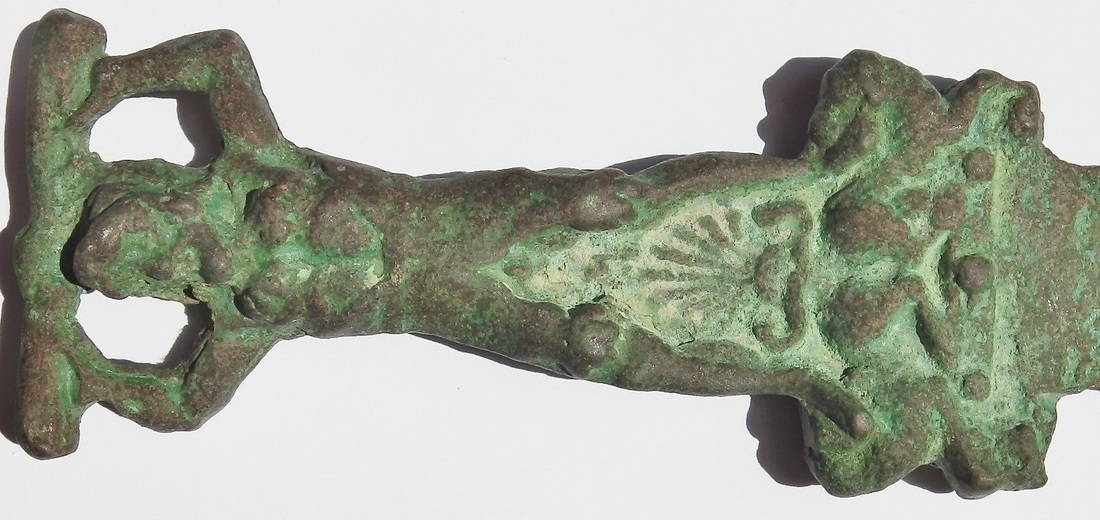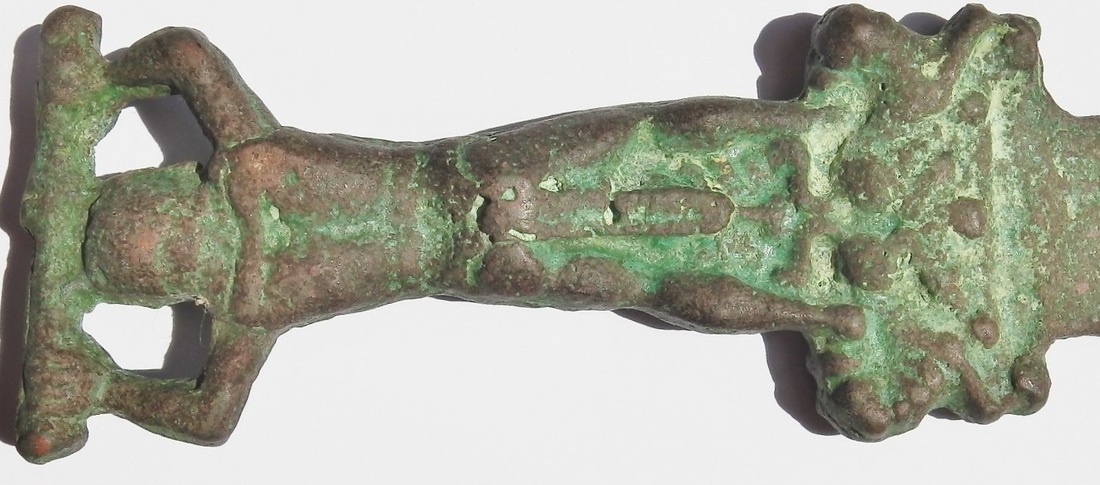The background story is generally in line with both what we know and what we assume. The sword was bought on vacation in Rome in 1988 from an antiques market vendor in the tourist zone close to the Vatican. It was sold as a supposed antique, with the dealer saying turn of the century or Grand Tour era. It was the only one in the shop and the only one seen on the trip. Knowing the purchase year is helpful because it aids in fine tuning the database. We now have six with confirmed original purchase dates and locations, with 1988 being the second oldest (the original purchase locations are tellingly limited to Pompeii and Rome).
Compared to the swords already in the database, the general matching physical qualities are obvious. The casting is a little rough and the verdigris patina is heavy and slightly worn from high spots. The patina is not worn so much, however, that burnished brass/bronze is showing. The bivalve mold seams are clearly visible and look similar to other database examples including Nova Scotia (Sword 1). There are signs of coarse grinding and filing to smooth out the seam burs. The blade is a thick, dull, uneven rectangular cross-section shape, and clearly not functional.
Sword 14 falls into Type J based on the salient "J" mark. The backwards J is a casting mold anomaly already seen in four previous examples: Nova Scotia (Sword 1), Florida (Sword 2), Italian eBay (Sword 4), and France (Sword 6). As noted, the backwards J is on the back of the blade and not the front like the others, so let's call it subtype "(r)", for "reverse."
There are a couple possible reasons for the J being on the back. Assuming new molds were made periodically or old molds were retrofitted into new models, and assuming that the bivalve components may have come in two parts, one for the blade and one for the hilt, perhaps blade halves were accidentally reversed, from one model to the next. Similarly, maybe an accident caused a mold to break at the splice and the repair accidentally reversed the blade halves. Conversely, maybe a new mold version reversed the blade halves on purpose to hide the obviousness of the J. Without more data it’s hard to say if there is a chronology of blade mold variations directly within the J group. It’s clear, however, that there must have been a time step where the blade component was reversed, and thus there are time steps with the J on the front, either earlier or later, or possibly both, than the J on the back.
The other anomaly of interest is the relatively distinct spot on the back of the blade which is slightly proud or almost embossed looking due to the way brighter patina encircles it. This is unique so far in the database. If it needs a name, maybe the Jupiter spot works. I was hoping it was a Spanish Maravedi coin stuck to the blade, but no such luck. On the front of the blade in reverse to the Jupiter spot, there is some wavy roughness and loss of thickness. Possibly some contamination or foreign material in the mold, or some other quality control issue would result in these anomalies. There is also a chance it is actually an after-the-fact patch.
Other minor characteristics are irregular shape near the tip and along blade edges, plus a small distinct dot beside the backwards J. There is a subtle match to the ridge line seen mid-blade in other examples in the same group. There are a couple of pitted marks on the back of the hilt, similar to random examples seen on other swords, which are likely caused by foreign bits of debris or simply bubbles trapped in the casting process.
Some initial research testing of Sword 14 has already been done. Testing of the alleged magical lodestone compass properties that would make the sword an authentic “ancient ocean navigational device” was undertaken using two methodologies. Firstly, using multiple redundant pieces of testing equipment (i.e., all the fridge magnets I could find), no magnetic qualities were determined that would pull you northerly with a firm grip on the sword, while sitting on or in a period replication of land or sea travel (i.e., an old skateboard or my inflatable beach lounge chair). Secondly, using a hydrostatic flotation platform (i.e., scrap plywood), the sword was placed in a hydraulic testing flume (i.e., my bathtub), upon which the entire assemblage did not spin to point the hilt north but rather it sank. Increasing the buoyancy of the flotation platform may be attempted with future efforts if more funding becomes available – fingers crossed that my research grant application pans out.
If you disagree with this summary analysis, then Sword 14 can be yours by sending me a certified check for $10,000, the same bamboozle price applied to Sword 1.
Database Entry:
Sword Number: 14
Sword name: Nova Scotia eBay
Type: J(r) (J with blade faces reversed)
Material: copper alloy (assumed brass)
Total length: 46cm
Blade length: 28.5
Hilt length: 17.5cm
Proximal blade width: 42mm
Mass: 1220g
Original purchase date: 1988
Original purchase location: Rome, Italy











 RSS Feed
RSS Feed
